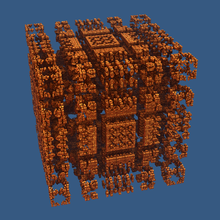- Mandelbox
-
In mathematics, the mandelbox is a fractal with a boxlike shape found by Tom Lowe in 2010. It is defined in a similar way to the famous Mandelbrot set as the values of a parameter such that the origin does not escape to infinity under iteration of certain geometrical transformations. However, unlike the Mandelbrot set, the mandelbox is defined a map of continuous Julia sets, and thus can be defined in any number of dimensions.[1] As a result, it is an example of a multifractal system. It is typically drawn in three dimensions for illustrative purposes.
Contents
Generation
The iteration applies to vector v as follows:
for (each axis) if (v[axis]>1) v[axis] = 2-v[axis]; else if (v[axis]<-1) v[axis] = -2-v[axis]; if (v.magnitude() < 0.5) v *= 4; else if (v.magnitude() < 1) v /= square(v.magnitude()); v = scale*v + c;A notable property of the mandelbox, particularly for scale -1.5, is that it contains approximations of many well known fractals within it.[2][3][4]
See also
Notes
References
- Leys, Jos (2010), Mandelbox. Images des Mathématiques, CNRS, http://images.math.cnrs.fr/Mandelbox.html
External links
Categories:- Fractals
Wikimedia Foundation. 2010.


